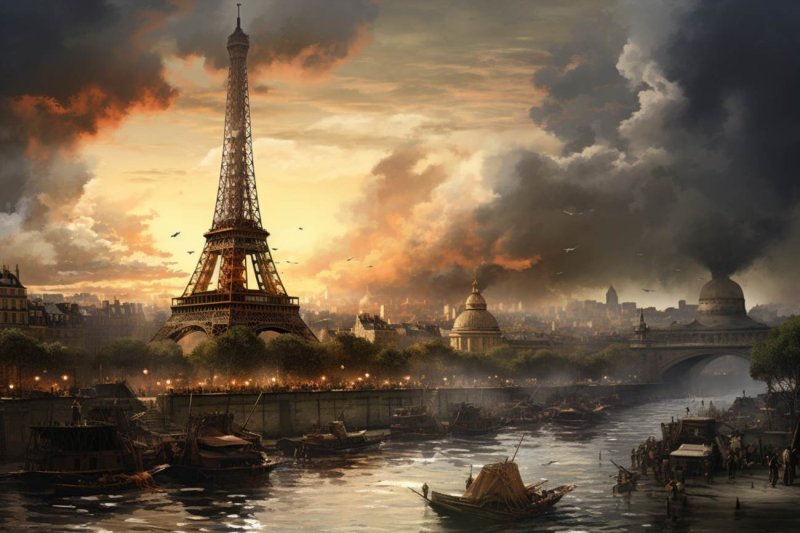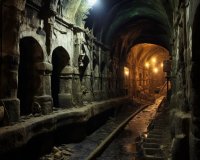The Evolution of Military History in Paris: From Revolution to World Wars

The Evolution of Military History in Paris: From Revolution to World Wars
Paris, often called the "City of Light," has a rich and diverse history that extends beyond its romantic ambiance and cultural landmarks. It is also a city that has played a significant role in the evolution of military history, from the tumultuous days of the French Revolution to the devastating World Wars of the 20th century. In this article, we will explore the fascinating journey of military history in Paris and the pivotal events that shaped it.
The French Revolution and Military Transformation
The late 18th century witnessed the birth of modern military tactics and the rise of Napoleon Bonaparte, whose military genius forever altered the landscape of warfare. Paris was at the heart of these transformative changes. The French Revolution, which began in 1789, not only led to political upheaval but also brought about a radical shift in military strategy.
The revolutionary government formed a new army, known as the French Revolutionary Army, which marked a departure from the traditional European methods of warfare. This army was characterized by its mass conscription, which saw ordinary citizens take up arms in defense of the Republic. Paris served as a crucial recruiting ground for this new army, and the city became a hub for military training and mobilization.
One of the most iconic military events of this era was the storming of the Bastille on July 14, 1789, which is celebrated as Bastille Day in France. This event symbolized the people's defiance against tyranny and marked the beginning of a new era in military and political history.
The Napoleonic Era
Napoleon Bonaparte's rise to power and his subsequent conquests had a profound impact on the military history of Paris and Europe as a whole. As the leader of France, Napoleon implemented innovative military strategies and tactics that allowed him to build a formidable army.
One of the most famous military landmarks in Paris from this period is the Arc de Triomphe, commissioned by Napoleon in 1805 to honor his Grande Armée. This iconic monument stands as a testament to Napoleon's military prowess and his ambition to create a lasting legacy.
However, Napoleon's military campaigns also brought the horrors of war to the streets of Paris. The city witnessed sieges, occupations, and the eventual defeat of Napoleon in 1814, leading to his exile to the island of Elba. Parisians experienced both the glory and the hardships of war during this tumultuous era.
World Wars and the Occupation of Paris
The 20th century brought two devastating World Wars that left an indelible mark on the military history of Paris. During World War I, Paris served as a symbol of French resistance and resilience. Although the city was not directly on the frontlines, it faced the challenges of supply shortages, air raids, and the emotional toll of the war.
World War II, however, brought a far more significant and somber chapter in Paris's military history. In 1940, Paris fell to Nazi Germany, leading to the occupation of the city for four long years. The Eiffel Tower, once a symbol of French pride, flew the Nazi flag, and the city's residents endured hardship and suppression.
But Parisians did not surrender their spirit. The French Resistance, composed of brave men and women, engaged in acts of sabotage and espionage to undermine the occupiers. The liberation of Paris in August 1944 by the Allied forces marked a turning point in the city's military history, symbolizing the triumph of freedom over tyranny.
Modern Military Paris
Today, Paris stands as a testament to the enduring spirit of a city that has witnessed both triumph and tragedy in its military history. The city is home to various military museums, including the Musée de l'Armée at Les Invalides, which showcases France's military heritage from ancient times to the present.
Paris also continues to be an important center for international diplomacy and military cooperation. It is the headquarters of several international organizations, including UNESCO and the OECD, which work towards promoting peace and security worldwide.
In conclusion, the evolution of military history in Paris reflects the city's resilience, adaptability, and its enduring commitment to freedom and democracy. From the French Revolution to the World Wars and beyond, Paris has played a pivotal role in shaping the course of military history in Europe and the world.
Paris Catacombs Skip-the-Line Guided Tour and Special Access
Discover the chambers below the streets of Paris and learn the secrets of the world’s largest underground burial site on a skip-the-line guided tour of the Paris Catacombs. Access areas not available to the general public.
Highlights
- Descend 20 meters below the streets to explore the Paris Catacombs
- Skip the lines and get special access to forbidden areas
- Learn why the remains of over 6 million people were transported underground in the 18th century
- Immerse yourself in the history of legendary struggles and triumphs
Full Description
Meet your guide at the Paris Catacombs and skip the lines to descend 20 meters below street level. Learn how 200 miles of tunnels were mined to solve the problem of the overcrowded cemeteries, and hear about the struggle and ultimate glory of the macabre, sacred site.
Get a feel for the amazing chambers as you pass the "Arrete. C'est Ici L'Empire De La Mort" ("Stop. Here is the Empire of Death") sign. Find yourself surrounded by bones and skulls, carefully arranged with reverence and a decorative flourish.
Enter special areas closed to the general public as you follow in the footsteps of the 18th and 19th-century French royals.
Includes
- Skip-the-line entry ticket to the Paris Catacombs
- VIP access to areas not available to the general public
- English-speaking guide
Meeting Point
From Metro station Denfert Rochereau (line 4 or 6), use Exit 1 to reach the street level. You’ll see the Catacombs entrance, with glass doors and a sign, across the street, located to the right of the small green building that was the former entrance. Your guide will be waiting with an orange "ExperienceFirst" sign.
Important Information
- What to bring: Comfortable shoes
- Not allowed: Pets, Smoking, Luggage or large bags
Know Before You Go
This tour includes an approximately 1-mile walk, with about 130 steps down and 85 steps back up to street level. It is not recommended for people who have mobility issues or suffer from anxiety in closed spaces. Please note that the temperature in the catacombs is around 14 degrees Celsius.
If the selected time is not available you will be offered options to reschedule. If you are unable to accept a reschedule option you will be offered a full refund.
Customer Reviews
Overall rating: 4.9 / 5 based on 237 reviews
Review summary:
- Guide: 5/5
- Value for money: 4.5/5
- Service: 4.8/5
- Organization: 4.7/5
The Rise and Impact of the French Revolution in Paris
The French Revolution, a pivotal event in world history, began in 1789 and had a profound impact on society, politics, and culture, not only in France but also across the globe. At its epicenter was the vibrant city of Paris, which witnessed the rise of revolutionary fervor and the subsequent transformation of the entire nation.
The discontent that led to the revolution was rooted in a variety of factors. France was grappling with a severe economic crisis, widespread social inequality, and an oppressive monarchy that favored the aristocracy. The burgeoning Enlightenment ideas and the success of the American Revolution further fueled the desire for change among the French populace.
On July 14, 1789, the storming of the Bastille marked the symbolic beginning of the French Revolution. This event was a manifestation of the people's frustration with the monarchy and its autocratic rule. The fall of the Bastille became a powerful symbol of liberty and the overthrow of tyranny.
The revolutionary wave that engulfed Paris and the rest of France brought about significant changes. The National Assembly was formed, and the Declaration of the Rights of Man and of the Citizen was adopted, emphasizing the principles of liberty, equality, and fraternity.
The revolutionary fervor continued to escalate, leading to the execution of King Louis XVI and Queen Marie Antoinette, the establishment of a republic, and the Reign of Terror. Paris became a center for radical political and social experimentation, with various factions vying for power and influence.
The Reign of Terror, characterized by mass executions and a climate of fear, had a lasting impact on the revolution and its perception. It eventually gave way to the rise of Napoleon Bonaparte, who established a new form of government, the Napoleonic Consulate, bringing an end to the revolutionary phase and initiating a new era in French and world history.
The French Revolution fundamentally altered the political and social landscape, paving the way for the spread of democratic ideals and inspiring future revolutionary movements worldwide. Its impact on Paris, as the heart of the revolution, remains ingrained in the city's history and is a reminder of the power of collective will and the quest for freedom and equality.
Les Invalides: Dive into French History at Napoleon's Tomb & Army Museum
Embark on a captivating journey through the rich tapestry of French history with a visit to Les Invalides. This iconic site, located in the heart of Paris, houses the Hotel National des Invalides, now home to the Musee de l'Armee.
Explore the extensive collections featuring over 500,000 artifacts spanning from the Middle Ages to the present day. Marvel at the gilded Dome des Invalides, a masterpiece that has cradled the resting place of Napoleon I since 1861.
Immerse yourself in the arms and armor collection, one of the world's largest, showcasing the military prowess of France. Wander through the museum's various sections, from the Dome Church, where Napoleon's tomb resides, to the Museum of Plans-Reliefs and the Museum of l'Ordre de la Libération.
Engage with history beyond the exhibits using interactive digital experiences. Devices provided enable visitors to gain a deeper understanding of pivotal battles that shaped France's destiny. Don't miss the temporary exhibition, Special Forces L'exposition, honoring the 30th anniversary of the Special Ops Command.
Whether admiring swords, cannons, uniforms, paintings, or personal belongings of historical figures, Les Invalides offers a profound glimpse into the essence of France. Your entry ticket provides access to permanent collections, temporary exhibitions, and the Dome Church housing Napoleon's tomb.
For a seamless experience, avoid queues by presenting your tickets at the entrance. Keep in mind that due to ongoing works, certain areas related to the First and Second World Wars are temporarily closed until June 30, 2023. Cloakrooms are unavailable, and museum admission is free for those under 18 and EU citizens under 26.
Make the most of your visit to Les Invalides, a testament to France's military and cultural heritage.
Includes:
- Permanent collections
- Dome Church (Napoleon's tomb)
- Museum of Plans-Reliefs
- Museum of l'Ordre de la Libération
- Temporary exhibitions
- Guided tour
- Multimedia guide
Meeting Point:
Avoid the long queue at the cash desk by presenting your tickets at the entrance of Les Invalides. Note that tickets may need to be shown for access to different parts of the site.
Important Information:
- Access to the site via the Esplanade des Invalides.
- First and Second World War areas are closed from January 9 to June 30, 2023.
- Cloakrooms are closed.
- Museum admission is free for those under 18 and EU citizens under 26.
- Tickets must be purchased onsite at the museum cash desk.
- Tills close 30 minutes before the museum's closing time.
- Closed on January 1, May 1, and December 25.
Price: From US$ 17.06 per person
Customer Reviews:
Overall rating: 4.6/5 based on 3442 reviews
Review Summary:
- Value for money: 4.5/5
- Service: 4.5/5
- Organization: 4.5/5
Selected Reviews:
"My family really enjoyed this experience. So much to see and enjoy. The audio guide confused me a bit, but we LOVED the whole experience."
"The family was less engaged than I was, so unfortunately, I have to give it a lower rating. Better suited for history buffs."
"Great experience! It will take 3+ hours to explore everything. Highly recommend, and don't forget all the models on the top floor."
Paris during the Two World Wars
Paris, the City of Light, has a rich history that includes its role during the two world wars of the 20th century. These tumultuous periods had a profound impact on the city and its people. Let's delve into the story of Paris during these trying times.
World War I: The Great War
When World War I erupted in 1914, Paris found itself at the center of the conflict. The city quickly adapted to the demands of the war effort. The Eiffel Tower was used for telegraphy, and the Louvre's artwork was evacuated to protect it from potential damage. Paris also became a hub for injured soldiers and a center for diplomacy.
Despite the hardships, Parisians displayed remarkable resilience. The war brought forth a wave of patriotism, with parades and celebrations taking place on the Champs-Élysées. It was a challenging time, but Paris emerged from World War I as a symbol of endurance and hope.
Between the Wars: A Time of Rebirth
Between World War I and World War II, Paris underwent a period of renewal and artistic flourishing. The 1920s are often referred to as the Roaring Twenties, a time of cultural renaissance. Paris was at the heart of this movement, with the likes of Ernest Hemingway, F. Scott Fitzgerald, and Josephine Baker frequenting the city's cafes and nightclubs.
Artistic movements like Surrealism and Cubism thrived in Paris, with luminaries such as Salvador Dalí and Pablo Picasso contributing to the city's creative atmosphere. The construction of iconic landmarks like the Art Deco-styled Palais de Tokyo reflected the spirit of the era.
World War II: The Dark Occupation
Tragically, the interwar period was merely a respite. In 1940, World War II descended upon Europe, and Paris fell under German occupation. The City of Light was dimmed as Nazi forces exerted control over the city. Many Parisians resisted, both actively and passively, through underground movements and acts of defiance.
The war years were marked by scarcity, curfews, and oppression. The Jewish population suffered greatly, with deportations to concentration camps. However, there were stories of courage, such as the actions of Raoul Wallenberg, who saved countless Jews in Budapest, including many with ties to Paris.
Liberation and Rebirth
Finally, on August 25, 1944, Paris was liberated from Nazi occupation by the Allied forces. The joyous celebration that followed is etched in the city's history. Charles de Gaulle, the leader of the Free French Forces, addressed a jubilant crowd at the Hôtel de Ville, declaring that Paris had been freed.
After the war, Paris embarked on a path of reconstruction. The scars of war were visible, but the indomitable spirit of Parisians shone through as they rebuilt their beloved city. The iconic Champs-Élysées, which had been damaged during the war, was restored, and Paris regained its status as a global cultural and artistic hub.
Conclusion
Paris during the two world wars witnessed moments of despair and resilience, darkness and light. The city's ability to endure, adapt, and emerge stronger is a testament to the spirit of its people. Paris remains a symbol of art, culture, and human resilience, and its history during the world wars is an integral part of its captivating story.






